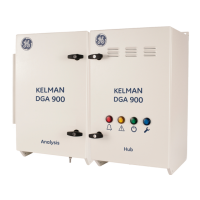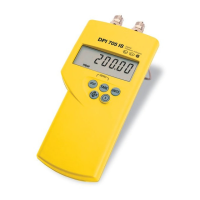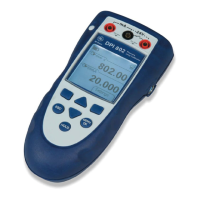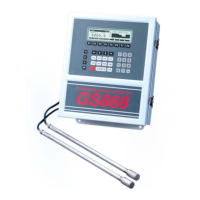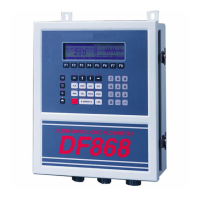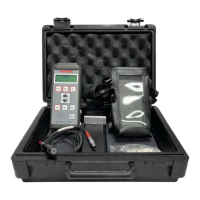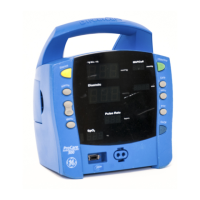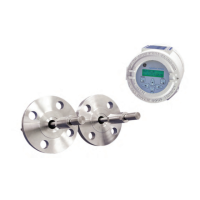Do you have a question about the GE DM5E and is the answer not in the manual?
Explains how to power the instrument using batteries.
Describes the procedure to turn the instrument on and off.
Lists the main features and functionalities of the DM5E instrument.
Lists the contents included with the DM5E Base Instrument.
Outlines the different available versions of the DM5E instrument.
Describes the structure and scope of the operating manual.
Explains the functions and operation of the instrument's keypad keys.
Describes the layout and elements of the DM5E's primary display modes.
Details how to adjust various DM5E settings via the Configuration display.
Guides on connecting a probe and loading compatible setup files for configuration.
Explains how to program instrument parameters for desired measurement configuration.
Covers the essential process of calibrating the instrument and probe for accuracy.
Describes how to set upper and lower alarm thresholds for measurements.
Explains how to adjust the B-SCAN display range for clearer scan graphs.
Details how to lock or unlock specific instrument functions for security.
Explains the different display modes for viewing thickness measurements.
Describes the Normal view mode, showing only the thickness reading.
Explains MIN SCAN and MAX SCAN modes for continuous thickness evaluation.
Details the DIFF/RR% mode showing measured vs. nominal thickness differences.
Describes the B-SCAN mode for graphical thickness display and analysis.
Explains the Dual-Multi mode to eliminate coating layers from metal thickness measurement.
Explains calibrating sound velocity for accurate thickness measurements.
Details the essential probe zero procedure before calibration.
Discusses how temperature variations affect calibration results.
Guidance on selecting suitable transducers based on condition and range.
Emphasizes consistent application of couplants for test accuracy.
Explains the "doubling" effect where readings are twice the actual thickness.
Guides on creating and naming data recorder files for storing measurements.
Explains how to retrieve or delete stored data files from the instrument.
Details storing thickness readings into data recorder files and navigating them.
Describes how to connect the instrument to a computer via USB for data transfer.
Lists the detailed technical specifications of the DM5E instrument.
Details features specific to the optional Data Recorder functionality.
Provides specifications for various DM5E probes and transducers.
Instructions on cleaning and maintaining the instrument housing and display.
Guidelines for handling cables to prevent damage and ensure longevity.
Information on battery inspection, replacement, and proper disposal.
Procedure to reset instrument software parameters to factory default values.
Steps for updating the DM5E's operating software using a PC.
Mentions additional information available on the GE Sensing & Inspection Technologies website.
Provides the DM5E Declaration of EMC Compliance and relevant EN standards.
Lists manufacturing details and global customer service contact information.
Information on the WEEE directive for proper product disposal.
Guidance on proper battery disposal and associated environmental and health risks.
Explains the meaning of markings indicating toxic metals in batteries.
Discusses risks of toxic metals in batteries and user's role in reducing impact.
Contact information for support in North and South America.
Contact information for support in the UK and Ireland.
Contact information for support in France.
Contact information for support in Germany.
Contact information for support in Spain.
Contact information for support in China.
Contact information for support in Japan.
Explains how to power the instrument using batteries.
Describes the procedure to turn the instrument on and off.
Lists the main features and functionalities of the DM5E instrument.
Lists the contents included with the DM5E Base Instrument.
Outlines the different available versions of the DM5E instrument.
Describes the structure and scope of the operating manual.
Explains the functions and operation of the instrument's keypad keys.
Describes the layout and elements of the DM5E's primary display modes.
Details how to adjust various DM5E settings via the Configuration display.
Guides on connecting a probe and loading compatible setup files for configuration.
Explains how to program instrument parameters for desired measurement configuration.
Covers the essential process of calibrating the instrument and probe for accuracy.
Describes how to set upper and lower alarm thresholds for measurements.
Explains how to adjust the B-SCAN display range for clearer scan graphs.
Details how to lock or unlock specific instrument functions for security.
Explains the different display modes for viewing thickness measurements.
Describes the Normal view mode, showing only the thickness reading.
Explains MIN SCAN and MAX SCAN modes for continuous thickness evaluation.
Details the DIFF/RR% mode showing measured vs. nominal thickness differences.
Describes the B-SCAN mode for graphical thickness display and analysis.
Explains the Dual-Multi mode to eliminate coating layers from metal thickness measurement.
Explains calibrating sound velocity for accurate thickness measurements.
Details the essential probe zero procedure before calibration.
Discusses how temperature variations affect calibration results.
Guidance on selecting suitable transducers based on condition and range.
Emphasizes consistent application of couplants for test accuracy.
Explains the "doubling" effect where readings are twice the actual thickness.
Guides on creating and naming data recorder files for storing measurements.
Explains how to retrieve or delete stored data files from the instrument.
Details storing thickness readings into data recorder files and navigating them.
Describes how to connect the instrument to a computer via USB for data transfer.
Lists the detailed technical specifications of the DM5E instrument.
Details features specific to the optional Data Recorder functionality.
Provides specifications for various DM5E probes and transducers.
Instructions on cleaning and maintaining the instrument housing and display.
Guidelines for handling cables to prevent damage and ensure longevity.
Information on battery inspection, replacement, and proper disposal.
Procedure to reset instrument software parameters to factory default values.
Steps for updating the DM5E's operating software using a PC.
Mentions additional information available on the GE Sensing & Inspection Technologies website.
Provides the DM5E Declaration of EMC Compliance and relevant EN standards.
Lists manufacturing details and global customer service contact information.
Information on the WEEE directive for proper product disposal.
Guidance on proper battery disposal and associated environmental and health risks.
Explains the meaning of markings indicating toxic metals in batteries.
Discusses risks of toxic metals in batteries and user's role in reducing impact.
Contact information for support in North and South America.
Contact information for support in the UK and Ireland.
Contact information for support in France.
Contact information for support in Germany.
Contact information for support in Spain.
Contact information for support in China.
Contact information for support in Japan.
| Brand | GE |
|---|---|
| Model | DM5E |
| Category | Measuring Instruments |
| Language | English |

